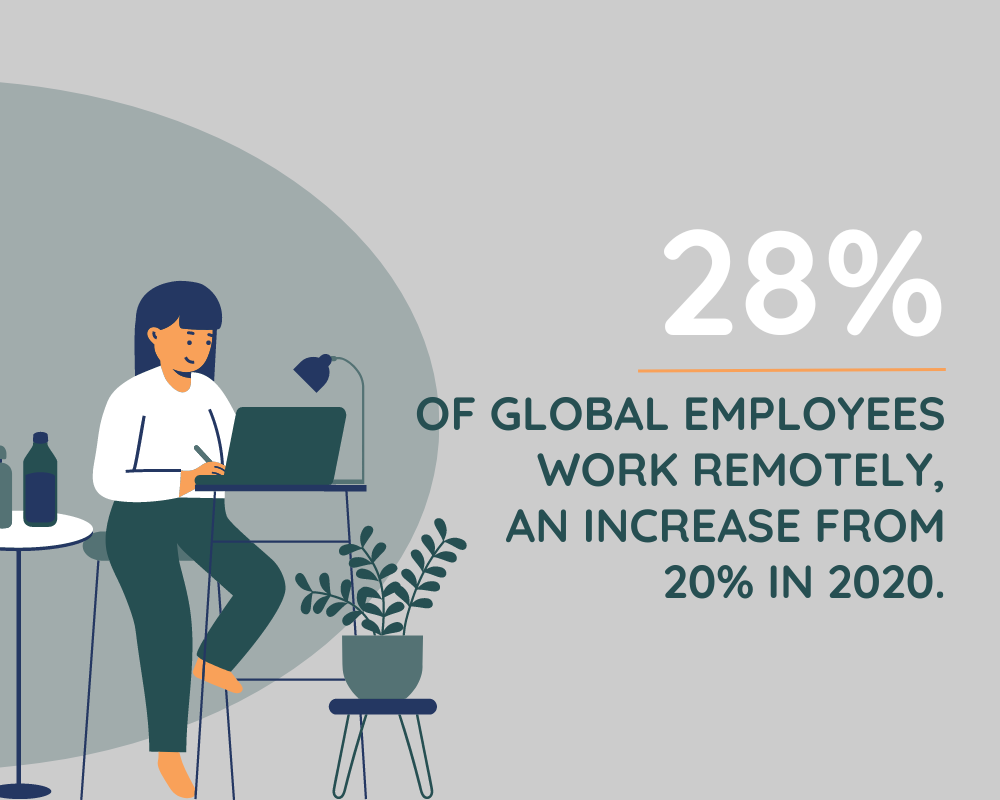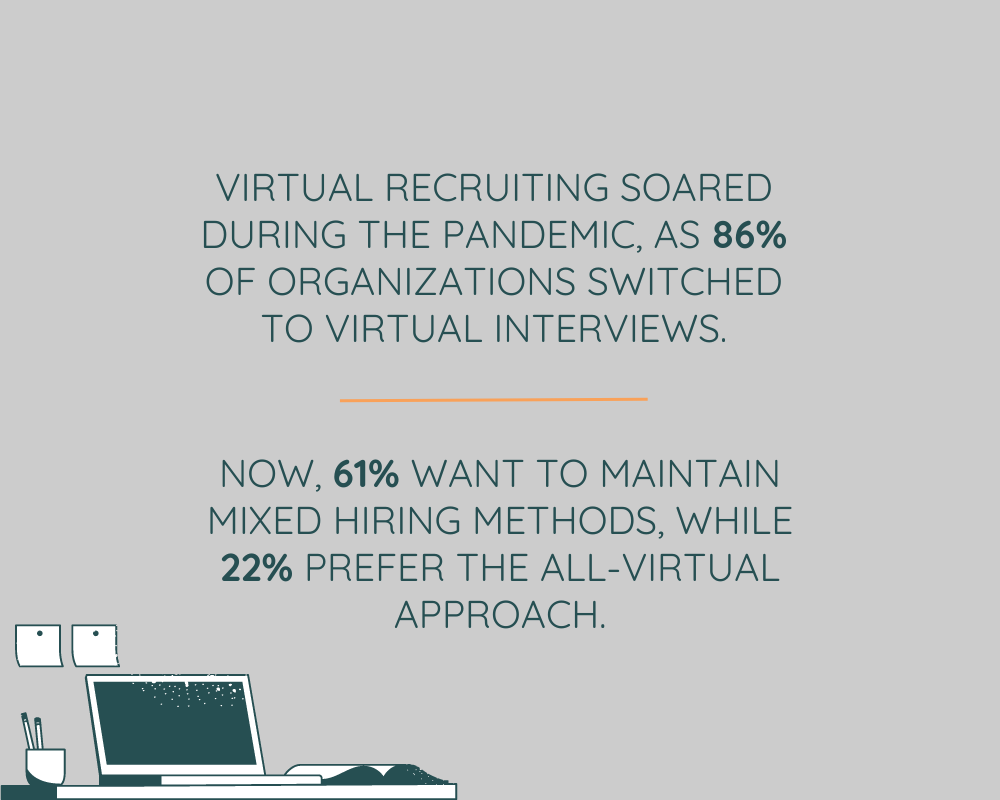
Best HR Podcasts for Professionals
Great HR is built on understanding human experiences. These HR podcasts share real stories by real experts for an insider look at the moments that shape careers and transform workplaces.

Remote work has undergone a significant shift in perception and practice, marked by a distinct “before and after,” which was the pandemic. This defining moment shattered conventional norms and revved its adoption on a global scale.
The “before” positioned this work model as a fringe benefit reserved for specific roles and industries. A broader use was met with reluctance, especially concerning employee productivity.
However, the “after,” although forced companies to embrace it out of necessity, gave a new definition to working remotely. It brought adaptability, digital transformation, and many other opportunities.
At the same time, it proved employers can remain productive. In fact, between the March and April 2020 lockdown, when fear and uncertainty were at their highest, companies saw a 47% surge in productivity.
Now, in the post-pandemic workplace, remote work is no longer an emergency response or a fringe benefit. Instead, it’s becoming a permanent fixture for some companies while driving a shift towards hybrid work models for others.
However, changes in technology, regulations, and employee needs continue transforming how work is conceptualized, executed, and managed.
That inevitably raises the question of what will happen to remote work.
To answer this, we look into some of the biggest remote work trends.
According to Statista, in 2023, 28% of global employees worked remotely, an increase from 20% in 2020.
Another study by Buffer reveals that 98% of respondents wanted to work remotely, at least some of the time. In fact, seeking flexible work environments was among the top three reasons employees search for new jobs after better pay and career opportunities.
As we move forward into 2024 and beyond, it’s evident that interest will continue to grow, giving rise to novel remote work trends that companies should closely monitor.

Remote work follows technological growth and vice versa.
Its beginnings date back to the early 80s when companies introduced telecommuting and telework. Over the next few decades, digital expansion and the internet made remote work more accessible, expanding it across many industries.
However, when the pandemic imposed global restrictions, the roles changed, and technology had to support the massive and sudden shift in the workplace.
More than ever, companies turned to video conferencing tools, project management platforms, and tracking and monitoring software.
The latter was so prevalent that it became known as “bossware”.
Following an increase in employee trends where they tend to “work less,” like the bare minimum Monday or lazy girl jobs, these employee monitoring platforms gained traction among employers doubtful of their workforce productivity.
In fact, a survey by Digital.com shows that 60% of companies use it to track their remote employees, and another 17% are considering it.
Currently, bossware functionalities range from screenshots and keystroke logging to activating employee cameras and microphones. With the expansion of AI, they can also generate productivity scores. One example is Enaible’s “trigger-task-time” algorithm, which enhances productivity tracking for remote employees.
Despite major privacy concerns, results show increased productivity after implementation, making this trend likely to continue.
Beyond this, as remote work keeps evolving, so will the expansion of video, communication, and collaboration tools, as well as project management platforms like Asana or Trello.
Hiring and recruitment software has become an excellent addition to remote work, and, as of the latest, we are seeing an emergence of software that aims to improve company culture.
In a decentralized workplace, maintaining company culture becomes challenging.
With employees working from different locations, offices are no longer the central spot for teamwork and socializing. Instead, we use virtual environments that can’t precisely replicate the social aspect of work.
Although employees overwhelmingly prefer remote work, 33% also agree that long-term, this will harm work culture. In the report for Gallup, 49% of exclusively on-site workers expressed the same concern.
From an employers’ perspective, according to the Society for Human Resource Management (SHRM), for 66% of CEOs, maintaining culture has been one of the biggest obstacles to talent management.
Communication and collaboration were a close second.
But as much as these are challenging, they also present an opportunity.
Companies are now looking for innovative ways to ensure their employees feel connected and aligned with the company’s values.
The result was a surge in developing and adopting software that tackles these issues.
For example, DingTalk by Alibaba, boasting a user base of 700 million, alongside platforms like Miro, MURAL, and Conceptboard, has expanded the collaboration and online whiteboard software market.
At the same time, Cleary helped create a more robust organizational culture in remote work environments, gaining the likes of companies like Square, Buzzer, DoorDash, Shippo, and Crypto.com.
The platform offers features such as milestone tracking, achievement celebration, and shoutout functionalities, along with the opportunity for employees to form social groups and share content outside work tasks.
With solutions allowing workers to manage their schedules, companies create new work culture trends based on autonomy and recognition while keeping the workforce engaged, productive, and connected.

The influx of flexible workers pushes for better policies and regulations.
While it used to be all about better telecommuting policies, now the focus is on privacy and cybersecurity.
However, despite the efforts, tracking technology expansion raises significant concerns.
Currently, employers are allowed by federal and state laws to monitor their workers’ activities on company-owned devices and networks, provided there is a legitimate business purpose.
While these tools offer benefits such as insights into productivity and performance, without clear guidelines and regulations, their use can infringe individual privacy rights and affect trust between employers and employees.
Some U.S. states, including New York, Connecticut, Delaware, and Texas, have successfully pushed for better legislation. Unfortunately, most remain without a legal obligation to inform the workforce about the use of this software.
Moreover, cybersecurity remains another significant concern.
OpenVPN poll reveals that 73% of IT leaders believe remote work poses a greater security risk than on-site work. In a separate survey by EY, 71% identified remote-working support as their organization’s top security challenge. Additionally, leading tech company Cisco reveals that for 85% of organizations, cybersecurity is more important now than during the pandemic.
Considering these numbers, looking ahead, we can expect to see efforts to improve remote work policies and regulations, as well as a heightened focus on cybersecurity measures and protocols to address these growing concerns.
Policymakers will need to collaborate with employers, employees, and cybersecurity experts to develop comprehensive frameworks that maximize the benefits while addressing potential risks and challenges.
At the same time, through transparency, companies can help create a supportive remote work environment that promotes productivity, trust, and employee well-being.
For companies that see remote work as unsustainable, hybrid work has emerged as a solution.
In 2020, amid the pandemic, BCG surveyed over 12,000 workers employed before and after COVID-19. Insights from the survey showed that 40% of the respondents were compelled to work remotely.
In a separate study, BSG also revealed that the same percentage of companies expect their employees to follow this work model in the future. Another 37% anticipated that more than a quarter of their workforce would combine remote and on-site work.
However, after the imminent danger of the pandemic passed, support for remote work declined.
One research shows that in 2021, only 13% of executives were on board with a fully remote workforce.
On a more positive note, the gap between employee preferences and company policies regarding remote work has decreased. Findings demonstrate that in late 2020, the disparity between the number of days employees desired to work remotely and the number of days companies permitted was 1.38 days.
By June 2022, this gap had lowered to 0.44 days.
So, while initial enthusiasm for working remotely waned after the pandemic’s peak, the appeal of hybrid work, with its blend of remote and on-site elements, stands out as a promising compromise.
The “after” of remote working transformed hiring and recruitment.
Companies embraced virtual technology for conducting job interviews, departing from traditional in-person methods.
According to Gartner poll results, the adoption of virtual recruiting soared during the pandemic, with 86% of organizations switching to virtual interviews.
In another survey by Jobvite, 61% responded that they wanted to maintain mixed methods for hiring, while 22% preferred the all-virtual approach.
The reason behind this changing dynamic of hiring and recruitment is that it benefits all parties.
For HR and hiring managers, it simplifies logistics and reduces time and resources to conduct candidate interviews.
For candidates, it offers convenience and accessibility. In fact, according to RecRight, 82.4% of the workforce reacted positively to video recruiting.
The bottom line is that as organizations continue to embrace remote hiring practices, the adoption of this technology is expected to rise, reshaping the landscape of recruitment strategies.

Considering all the shifts and trends, it’s safe to assume that remote work in 2024 will keep transforming how we labor, collaborate, and innovate.
Thus, the following predictions and challenges emerge.
The disconnect between what employers want and what employees ask for remains.
While workers want to double their time working from home, some managers still push for more in-office presence, leading to potential conflicts. A rise in unemployment might give companies more leverage over the work conditions.
However, employers will keep bridging the gap between employee preferences and company policies.
In fact, by the end of 2024, over two-thirds of U.S. companies are predicted to offer flexible work arrangements. Support for hybrid work solutions could prevent increased turnover and boost employee satisfaction and productivity, ultimately enabling a more resilient and adaptable workforce.
Transparency will continue to be imperative in the workplace.
In fact, 86% of leaders agree that increased organizational transparency correlates with higher levels of trust within the workforce. However, only 52% are doing something about it. Thus, pushing for an employee-centric environment focused on trust, engagement, and accountability will be crucial for retaining top talent and driving long-term success.
Technology will keep evolving, allowing for more opportunities in a decentralized workplace.
Ongoing advancements in collaboration tools, virtual communication platforms, and the integration of AI will impact efficiency and collaboration in remote work processes while also contributing to transparency. However, this increased reliance on digital platforms continues to raise concerns about data privacy and cybersecurity.
As employers prioritize remote work policies that foster work-life balance and overall employee well-being, data analytics and insights will emerge as vital tools.
By leveraging data, companies can effectively measure remote workforce performance and pinpoint areas for improvement. This partnership will ensure that remote environments are attentive to employee well-being and optimized for engagement and growth.
While many industries still can’t support this model, and few will never be able to, those that can will likely explore the fully remote or hybrid option to keep up with employee needs.
As a result, employer responsibilities will evolve to include the delicate balance between meeting worker preferences and achieving organizational objectives.
Thus, remote work becomes increasingly vital for talent retention and productivity, and its importance will only continue to grow, ensuring its enduring presence in the future of work.
Content Writer at Shortlister
Browse our curated list of vendors to find the best solution for your needs.
Subscribe to our newsletter for the latest trends, expert tips, and workplace insights!

Great HR is built on understanding human experiences. These HR podcasts share real stories by real experts for an insider look at the moments that shape careers and transform workplaces.

Promoting without a plan? That’s how managers fail. Instead, use a 90-day framework to turn raw potential into strong leadership.

Who’s responsible for shaping your employee experience and culture? If it’s unclear, you’re already falling behind companies that treat it as a priority.

Employee background assessments are subject to legal responsibilities under the Fair Credit Reporting Act. What does an FCRA background check mean for employers, and what do they need to know before doing one?
Used by most of the top employee benefits consultants in the US, Shortlister is where you can find, research and select HR and benefits vendors for your clients.
Shortlister helps you reach your ideal prospects. Claim your free account to control your message and receive employer, consultant and health plan leads.